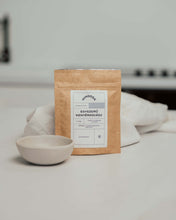Sourdough – fortunately for our digestive systems – is enjoying a true renaissance. Many people nurture their own wild sourdough at home, with varying degrees of success, and more and more are becoming truly skilled at preparing this essential component of fermented breads. Enthusiastic bakers share recipes and tips on social media, but small and large debates often arise about what sourdough actually is, whether it contains yeast, and whether those with yeast allergies can eat it.
Luca Tavus, dietitian at MIMOOSA, has thoroughly explored the topic and provides answers to your questions about yeast allergy.
BASIC CONCEPTS
What is yeast?
Yeast is a single-celled fungus involved in fermentation processes. In everyday language, yeast usually refers to baker’s yeast – a logical term, as it is one of the main ingredients in baking, giving life to breads and pastries. Yeast is responsible for the lightness and rise of breads, as the carbon dioxide it produces increases the dough’s volume.
What is sourdough?
Sourdough is a mixture full of living microorganisms, made with only two ingredients: flour and water. By mixing these ingredients and feeding them daily, spontaneous fermentation begins. This process transforms the initial ingredients into sourdough. (Important: gluten-free sourdough can only be made from gluten-free flour!)
Traditional sourdough is a suspension of flour and water that provides an ideal environment for the growth of lactic acid and acetic acid bacteria, as well as certain yeasts. Various yeast strains naturally exist in our environment – in flour and on our hands. Under favorable conditions – in this case, flour and water at the right temperature – the fungi multiply. The essence of sourdough is the microorganisms it contains, which enable the production of well-known sourdough breads. Flour and water serve as the culture’s medium and carrier. Research shows that each sourdough is completely unique, containing different microorganisms in varying proportions. Sourdough and the bread made from it always contain yeast! For people with yeast allergies, the effect on the body is the same whether it’s baker’s yeast or the yeast formed in sourdough.
What is different about MIMOOSA bread starter?
The MIMOOSA bread starter – or sourdough culture – is a special bacterial culture containing lactic acid bacteria and selected yeast strains, i.e., all the microorganisms that develop during traditional sourdough fermentation. This bread starter always contains the same species in the same proportions. The culture contains no flour or water, only the bacteria and yeasts necessary for fermentation, along with carriers to allow precise dosing. [Read more about the sourdough culture here.]
Can someone with a yeast allergy eat sourdough bread?
No! Verified yeast-allergic individuals cannot consume products made with sourdough, as they also contain yeast to some extent. Therefore, anyone with a yeast allergy cannot eat bread made with either sourdough culture or traditional sourdough.
Can someone with yeast intolerance eat sourdough bread?
Generally, yes, depending on individual tolerance. Sourdough bread usually does not cause symptoms in cases of yeast intolerance. However, it is recommended to consult a gastroenterologist and/or dietitian to plan the diet and monitor symptoms.
WHAT IS THE DIFFERENCE BETWEEN YEAST ALLERGY AND YEAST INTOLERANCE
Yeast allergy should not be confused with yeast intolerance.
YEAST ALLERGY
Yeast allergy is extremely rare. Most commonly, it is caused by proteins in Saccharomyces cerevisiae (baker’s yeast), which is also found in brewer’s yeast. In allergy, the body recognizes these proteins as foreign and produces antibodies, potentially causing symptoms. Cross-allergy with other yeasts can occur, so it is advisable to avoid all yeast-containing foods. Symptoms may appear after consuming yeast-containing foods or inhaling allergens.
Symptoms of yeast allergy may include:
- Skin reactions like eczema or hives
- Respiratory issues such as coughing, nasal congestion, shortness of breath, or asthma
- Digestive problems including bloating, cramps, vomiting, diarrhea
- Very rarely, severe cases may trigger anaphylactic shock
In case of a yeast allergy, no yeast-containing foods must not be consumed.
Diagnosis:
- Prick or epicutaneous tests
- Allergy (IgE) blood test
Yeast intolerance
Yeast intolerance resembles an allergy but is not immune-mediated. Instead, the body cannot properly digest yeast, causing various gastrointestinal symptoms such as:
- Bloating
- Abdominal pain
- Diarrhea
- Constipation
It is very important to note that IgG tests do not provide reliable results, so excluding yeast from the diet based solely on such a test is not necessary. The best way to identify intolerances is through an elimination diet, which should be conducted under the supervision of a gastroenterologist and with the guidance of a dietitian. This diet involves removing the food(s) suspected of causing symptoms – in this case, yeast – from the diet for a period determined by a specialist, and then gradually reintroducing them. If symptoms reappear during reintroduction, the food should continue to be excluded.
Supervision of the diet is necessary to ensure that only the absolutely necessary foods are excluded, and only for the justified duration. This approach also helps prevent the development of nutritional deficiencies.
Foods to avoid with yeast intolerance
In addition to bakery products (rolls, pizza, breadcrumbs, donuts, etc.), many alcoholic beverages (beer, wine) and various fermented foods contain yeast. Avoid soy sauce, miso paste, vinegar, kefir, and any foods containing them. Yeast can also be present in supplements, cosmetics, and medications.
Always read ingredient lists carefully to prevent symptoms. If unsure, avoid the product.
TIPS FOR YEAST-FREE BREAD IN CASE OF YEAST ALLERGY
You don’t have to give up bread, just use alternative methods instead of traditional yeast or sourdough:
Make a slightly different but delicious bread (e.g., bodag bread) using baking powder. Use a phosphate-free version to avoid digestive issues.
Baking soda and lemon juice can also be used to make bread, such as Irish soda bread.
Flatbreads and simple loaves can be made with just bread flour, water, a pinch of phosphate-free baking powder, and salt.
Naan bread can be made by combining bread flour, phosphate-free baking powder, and plain (plant-based) yogurt. From this dough, you could even make bagels!
Author: Luca Tavus – Dietitian


